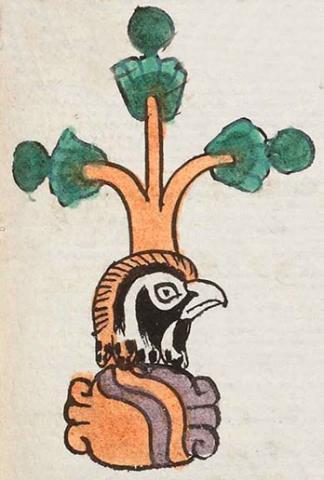Tezoltzapotlan (Mdz48r)
This compound glyph for the place name Tezoltzapotlan has three notable visual components, a stone (tetl), a quail's head (zol(in)], and a sapote tree (tzapotl). The tree has two branches and a leader. The green vegetation is two-toned, with balls (likely, the fruit) on stems protruding from the foliage. The quail head recalls the Montezuma quail. And, the stone is a horizontal stone with classic curling ends and wavy purple and orange alternating lines. The -tlan locative suffix is not presented visually, but perhaps the landscape provides a semantic locative.
Stephanie Wood
As Gordon Whittaker points out, the -zol- element is a phonetic indicator for the adjectival suffix "zol" which means old or wretched. It is not necessarily a place with quail.
In the other examples of the tzapotl (zapote, sapote) that we have from various compound glyphs (below right), we see green balls (an apple-like fruit) in lieu of the stones. Some of these trees have one, two, or three fruits per branch. Alonso de Molina translates tzapotl as "cierta fruita conocida," a type of fruit that is known (i.e. locally]. Some call this tree the Mexican apple, or "sapote tree" in English. According to Wikipedia, the fruit is edible, it contains pharmacological properties such as histamines, and the seeds may have been used by the Aztecs to make poison.
Stephanie Wood
teuh çoltzapotlā. puo
Tezoltzapotlan, pueblo
Stephanie Wood
c. 1541, but by 1553 at the latest
Stephanie Wood
stones, quail birds, sapotes, codornices, árboles, zapotes, piedras, fruits, frutas, trees, branches, roots, árboles, ramas, raíces, nombres de lugares

te(tl), stone or rock, https://nahuatl.wired-humanities.org/content/tetl
zol(in), quail, https://nahuatl.wired-humanities.org/content/zolin
tzapo(tl), sapota or zapote fruit tree, https://nahuatl.wired-humanities.org/content/tzapotl
-tlan (locative suffix), place, https://nahuatl.wired-humanities.org/content/tlan
"By the Dusty Old Zapote Trees" (Whittaker, 2021, 95)
te-zol-TZAPO.
Codex Mendoza, folio 48 recto, https://digital.bodleian.ox.ac.uk/objects/2fea788e-2aa2-4f08-b6d9-648c00..., image 106 of 188.
The Bodleian Libraries, University of Oxford, hold the original manuscript, the MS. Arch. Selden. A. 1. This image is published here under the UK Creative Commons, “Attribution-NonCommercial-ShareAlike 3.0 License” (CC-BY-NC-SA 3.0).



